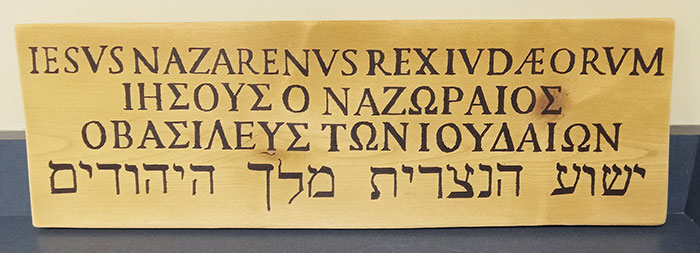
Artwork by Ray Mantsch
By Thom Heenen
Question Box Column
Q. What does ‘INRI’ on the sign above Jesus on the crucifix mean?
A. Great question! While you might not find this on every crucifix, it is on most. It is an acronym for “Jesus the Nazarene, King of the Jews.” In the Latin it would be Iesus Nazarenus Rex Iudaeorum. Taking the first letter of each of those Latin words gives you “INRI.” Why “I” and not “J,” you ask? As everyone who has seen Indiana Jones and the Last Crusade knows, there is no “J” in Latin.

John’s Gospel recounts that Pontius Pilate “had an inscription written and put on the cross. It read, ‘Jesus the Nazorean, the King of the Jews’” (John 19:19; both spellings, “Nazarene” or “Nazorean” are acceptable). It goes on to say the inscription was written in Hebrew, Latin and Greek. The chief priests objected, “Do not write ‘The King of the Jews,’ but that he said, ‘I am the King of the Jews’” (John 19:20-21), to which Pilate famously replied, “What I have written, I have written” (John 19:22). What Pilate meant by that we may never know, but the inscription, likely meant as a mockery, proclaimed truth nonetheless. On some larger crucifixes you might find the whole phrase written out in all three languages, just as mentioned in John’s Gospel.
This got me thinking about some of the other “alphabet soup” we find in popular Christian symbolism. Perhaps the most common is what looks like the letter “P” superimposed on what looks like an “X.” These are not the letters “X” or “P,” but the Greek letters “Chi” (which makes a hard “K” sound) and “Rho” (which makes the “R” sound). These are the first letters in the Greek XPISTOS, Latinized as CHRISTOS, and in English as “Christ.” By the way, “Christ” is not Jesus’ last name, but a title, which literally means “anointed one.” It is the same word we get the word “chrism” from (recalling last week’s question). The closest thing to a “last name” for Jesus would be “of Nazareth,” or “Son of Joseph,” as he is referred to in John 6:42.
Another common set of letters you will find in churches is “IHS.” This is an abbreviated form of the name of Jesus, using the first three letters of his name in Greek. Over time it also became used as shorthand for the phrase in Latin, “Iesus Hominis Salvator,” meaning, “Jesus, Savior of men,” including women, of course. The Jesuit monogram famously incorporates this and it can be found on the papal coat of arms of Pope Francis, our first Jesuit pope.
Slightly more rare, you might find what is call the “Icthys,” which would look like this in the Greek characters: ΙΧΘΥΣ. This happens to be the word in Greek for “fish,” the symbol of which was used as a kind of code by early Christians to identify themselves in times of persecution (and now found on many a car tailgate). Latinizing this some, the letters of the word Icthys in Greek provide their own acronym: Iesous Christos Theou Yios Soter, meaning “Jesus Christ, Son of God, Savior.”
Next time you are in a church, look around and see how many of these you can find!
(Father Thom Hennen serves as the pastor of Sacred Heart Cathedral in Davenport and Vicar General for the Diocese of Davenport. Send questions to messenger@davenportdiocese.org)










